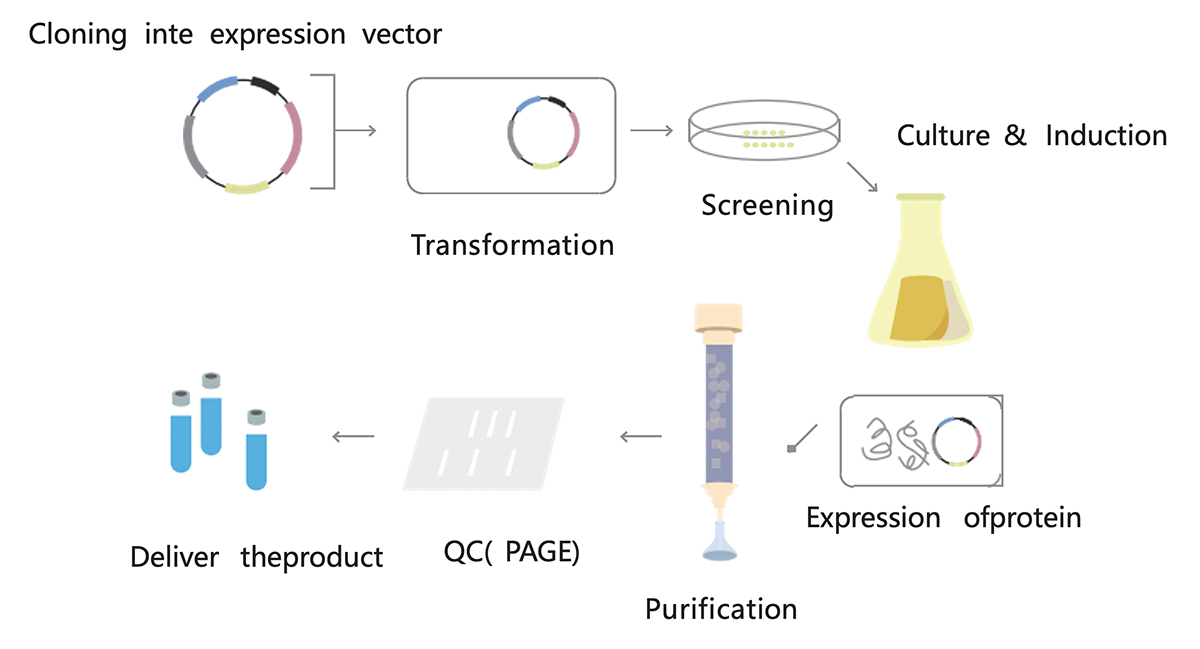E. coli Expression System
Escherichia coli is the most widely used and cost-effective protein expression system. Escherichia coli is featured for its clear genetic background, rapid cell proliferation, high expression level, good stability and resistance to contamination by other microorganisms. Escherichia coli can be used for expressing various proteins, especially for soluble proteins with low molecular weight or prokaryotic membrane proteins. AlpHelix has a variety of Escherichia coli strains and expression vectors. AlpHelix scientists have rich experience in the expression and purification of soluble and membrane proteins using various Escherichia coli strains. AlpHelix scientists are also good at refolding denatured soluble and membrane proteins.
Types of E. coli Expression Systems
1.T7 system
T7 system is constructed by combining T7 promoters and elements of the T7 phage transcription system. T7 RNA polymerase is of high activity. Its mRNA synthesis speed is five times that of the RNA polymerase of Escherichia coli. Moreover, some sequences that cannot be transcribed by the Escherichia coli RNA polymerase can be transcribed by T7 RNA polymerase. Therefore, in the presence of T7 RNA polymerase and T7 phage promoter, the transcription system of Enterobacter coli itself cannot compete with the T7 phage transcription system, which ultimately takes control of protein transcription by the T7 phage promoter.
2.Lac and Tac E. coli expression systems
The Lac and Tac E. coli expression systems are designed upon the regulatory mechanism of the E. coli Lac operon. The system consists of multiple units that are arranged in the order promoter (lacP)-operator (lacO)-structural genes (lacZ-lacY-lacA)
Lac operon system: The LacI repressor is assembled into a tetramer in absence of an inducer. The tetramer, by tightly binding to the operator that is downstream of a promoter, inhibits transcriptional initiation. When an inducer (e.g. IPTG) is present, the inducer binds to LacI protein, relieving the suppressive effect of LacI protein and thereby activating operon transcription. Similarly, the expression system under the control of the tac promoter is called the Tac expression system.
3.PL and PR E. coli expression systems
The PL and PR E. coli expression systems are constructed based on the early transcriptional promoters of the λ phage, PL and PR. The PL and PR promoters initiate protein expression at high temperature without the need of chemical induction, making them cost-effective. In fact, several medicinal recombinant proteins were produced in this E. coli expression system.One of drawbacks of the PL and PR systems is that some proteases in E. coli are activated upon heat shock and thus degrade overexpressed recombinant proteins. Additional drawback of the PL and PR systems includes the requirement of a long time to reach a high temperature for large-scale fermentation. Consequently, the efficiency of heat-induced expression is impaired. The thermostability is also an limiting factor for producing recombinant proteins.
| T7 expression system | Advantages | Disadvantages |
| T7 system | Efficient expression of the target proteins | background is noisy |
| Lac expression system | Easily regulated by its operon | Unsuitable for preparing medicinal proteins |
| Tac expression system | Easily regulated by its operon; higher transcription levels than Lac does | Unsuitable for preparing medicinal proteins |
| PL and PR expression systems | No need of chemical inducers; low cost and strong transcriptional ability | The recombinant proteins are prone to proteolysis |
AlpHelix offers expert-level E. coli expression services
AlpHelix has various E. coli strains, including TOP10, BL21(DE3), Rosetta (DE3), Origami (DE3), C41(DE3), C43(DE3), BL21 (DE3) CondonPlus, BL21(DE3) pLysS, Rosetta (DE3) pLysS, and Rosetta-gamiB (DE3) pLysS. Many strains are T7-based. AlpHelix also has M15 (pREP4) and SG13009 (pREP4) that are T5-based. Clearcoli strain is of very low endotoxin background.
We provide the following expression services:
· Protein expression at different temperatures (16℃-37℃) ;
· Protein expression in various culture media (LB, TB, 2xYT, M9, etc.);
· Protein expression using different inducers (IPTG induction, arabinose induction, auto-induction, etc.);
· Co-expression with chaperones to improve fold and solubility;
· High-throughput expression test in 96-well format;
· Other tailored services, such as customized fusions, tags and modifications;

| 1-2weeks | 1-2weeks | 1 week | 2-3weeks | 2-3weeks |
| Gene synthesis and codon optimization (optional) | Expression constructs generation | Expression test and solubility analysis | Pilot expression and purification | Large-scale expression and purification (optional) |
| Customer provides a protein sequence, or provide AlpHelix with expression constructs | · Cloning genes into expression vectors · vector sequencing · vector preparation Deliverables · Sequencing report (if requested by the customer) |
· 10mL culture · Expression tests in three individual conditions · Protein expression evaluation (SDS-PAGE) Deliverables · Expression evaluation report |
· Purification of proteins in their soluble forms · Protein denaturation, refolding, and purification (inclusion bodies) · QC analysis (SDS-PAGE, UV, etc.) Deliverables · 0.5-1 mg purified protein (if protein’s expression level is reasonable) · Certificate of Analysis(COA) |
· 100mg and above · QC analysis Deliverables · Purified protein · Certificate of Analysis(COA) |
For more information about our technology and services, please contact us.
Contact Us